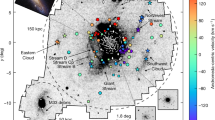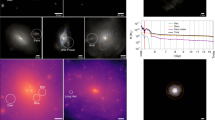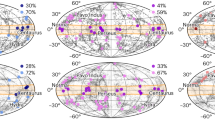Abstract
THE idea that galaxies may be surrounded by large amounts of unseen material has become very popular. The arguments favouring such massive haloes are almost all based on the dynamical analysis of galaxies either individually or in groups, and they have been cogently assembled by Einasto et al.1 and by Ostriker et al.2. They concluded that galaxies may well be surrounded by large (∼ 100 kpc) or very large (∼ 0.5 Mpc) ‘isothermal haloes’ whose mass varies as the radius within which it is measured. (We take H0 = 50 km s−1 Mpc−1). Their views have subsequently received support from Arecibo observations which found flat HI rotation curves to very large radii for several spiral galaxies3, and from analyses of the dynamics of new samples of binary galaxies4 and of groups of galaxies5. The most extreme form of the massive halo hypothesis postulates very large haloes which are the dominant constituent of the Universe, and in which the observed galaxy is little more than contaminating debris left over from the formation of the unseen object6. It is disquieting that there seems to be little chance of direct observation of this dark material, and this letter points out that dynamical constraints can be put on either the extent or the universality of galactic haloes.
This is a preview of subscription content, access via your institution
Access options
Subscribe to this journal
Receive 51 print issues and online access
$199.00 per year
only $3.90 per issue
Buy this article
- Purchase on Springer Link
- Instant access to full article PDF
Prices may be subject to local taxes which are calculated during checkout
Similar content being viewed by others
References
Einasto, J., Saar, E., Kaasik, A. & Chernin, A. Nature 252, 111–112 (1974).
Ostriker, J. P., Peebles, P. J. E. & Yahil, A. Astrophys. J. 193, L1–L4 (1974).
Krumm, N. & Salpeter, E. E. Astr. & Astrophys. 56, 465–468 (1977).
Turner, E. L. Astrophys. J. 208, 20–29 (1976); 208, 304–316 (1976).
Gott, J. R. & Turner, E. L. Astrophys. J. 213, 309–322 (1977).
Yahil, A. Astrophys. J. (in the press).
White, S. D. M. Mon. Not. R. astr. Soc. 177, 717–733 (1976).
Richstone, D. O. Astrophys. J. 200, 535–547 (1975); 204, 642–648 (1976).
van Albada, T. S. & van Gorkom, J. H. Astr. Astrophys. 54, 121–126 (1977).
Author information
Authors and Affiliations
Rights and permissions
About this article
Cite this article
WHITE, S., SHARP, N. Tidal interactions and the massive halo hypothesis. Nature 269, 395–396 (1977). https://doi.org/10.1038/269395a0
Received:
Accepted:
Issue Date:
DOI: https://doi.org/10.1038/269395a0
This article is cited by
-
Optimum merger time-scales and binary evolution
Astrophysics and Space Science (1993)
-
A dynamical study of the frequency of merging galaxies
Astrophysics and Space Science (1987)
-
Homogeneous sample of double galaxies. II. Orbital masses
Astrophysics (1982)
-
Peculiarities of binary galaxies
Nature (1980)
Comments
By submitting a comment you agree to abide by our Terms and Community Guidelines. If you find something abusive or that does not comply with our terms or guidelines please flag it as inappropriate.



